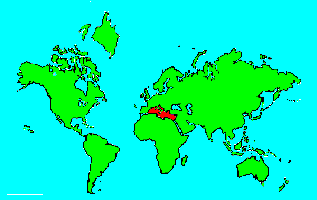SPECIES INFO
Smooth back monkfish or smooth back angelshark (Squatina occulata) is found in the Mediterranean and then south along the western Africa coast almost to Angola. This is becoming rare in the Mediterranean. The drawing in Lythgoe shows two dark spots on each pectoral fin and several dark spots near the two dorsal fins which are set way back on the body.Angel shark genus (Squatina) contains about 18 species of sharks. These sharks are flat bodied and can be found lying on the bottom. Some people confuse these sharks with rays. The angel sharks have pectoral fins that are separate from the head and pelvic fins.
Angel Sharks (Family Squatinidae) comprise an unusual group of sharks that look like rays. They are also called monkfish. The broad head and the giant pectoral fins give the front of this shark a triangular outline when viewed from above. They are not common. Following are some of the perhaps sixteen to twenty species in this family:
Atlantic Angel Shark - Squatina dumerili - Atlantic Coast
European Angel Shark - Squatina squatina - Near Europe
Pacific Angel Shark - Squatina californica - Alaska to Chile
Orange Angel Shark - Squatina tergocellata - Australia
ngel sharks are found typically in cool temperate shallow areas. The unusual large wide pectoral fins will help identify these sharks. The flatenned head and large pectoral fins give the front half of the dorsal view of this shark a unique triangular appearance. There is only one family in this order. There is only one genus in the family.
Sharks and rays (Elasmobranchi), cartilaginous fishes, deserve to be a class separate from the normal fish, in that they do not have a bone skeleton but rather a cartilage skeleton.
Fertilization is internal in this class which also separates them from the bony fish class. Although there are a few fresh water species, the majority of the species in this class are found in salt water. As of 2005, there were about 500 known species of sharks and about 600 known species of rays.
David Ebert, author of a recent book on sharks, rays, and chimaeras of California, counts a total of 988 described species in the class with about 150 additional species awaiting scientific description. He breaks down the described species to 410 species of sharks, 543 species of rays, and 35 species of chimaeras.
Many species of sharks face an uncertain future, as the Chinese purchase shark fins to make shark fin soup. It was estimated that 100 milllion sharks are killed each year for this purpose. However, recent estimates indicate the Chinese are reducing their consumption of this exotic soup.
Backboned Animals (Phylum Chordata) are the most advanced group of animals on earth. These animals are characterized by having a spinal cord or backbone. Most members have a clearly defined brain that controls the organism through a spinal cord. Fish, amphibians, reptiles, birds, and mammals are in this phylum.
Currently, some taxonomists believe that the fish should be divided into two groups (sharks and regular fishes) and that there are some other primitive groups in the phylum such as hagfish or lampreys.
Animal Kingdom contains numerous organisms that feed on other animals or plants. Included in the animal kingdom are the lower marine invertebrates such as sponges and corals, the jointed legged animals such as insects and spiders, and the backboned animals such as fish, amphibians, reptiles, birds, and mammals.

